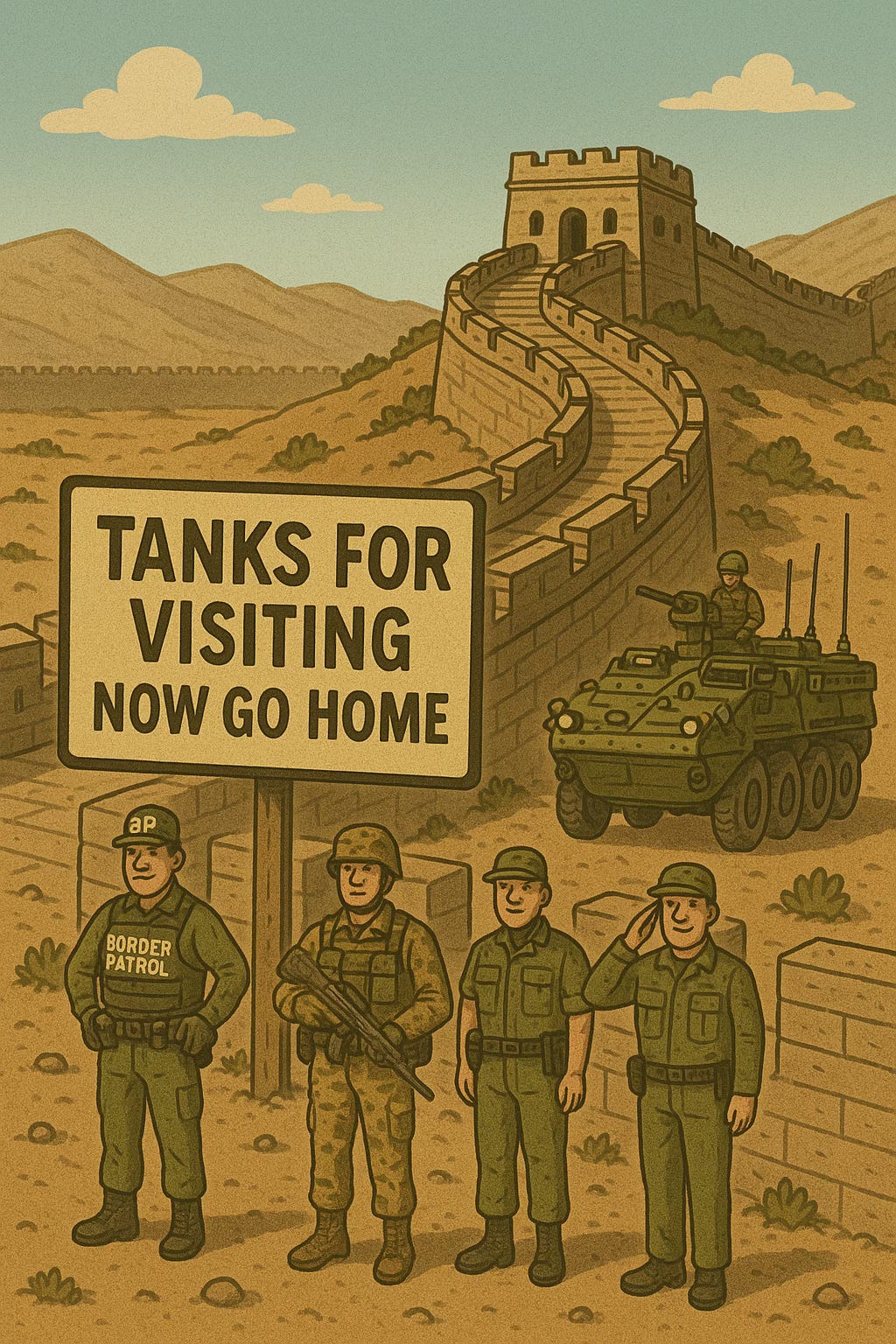As we examine the plethora of Executive Orders (EOs), off-the-cuff comments, and u-turns coming from the White House on a daily basis, it’s easy to miss the forest for the trees, as my grandmother used to say.
I’ve been noodling away on a post regarding the implications of the SAVE Act - another on erasing history- and one on immigration in general - but I put them to the side when this dropped.
On Friday, April 11, 2025, President Trump issued National Security Presidential Memorandum/NSPM-4. The memo is addressed to the Secretaries of Defense, Interior, Agriculture, and Homeland Security and outlines a strategy for deploying military resources to repel what the administration describes as an “invasion” and to seal the border against unlawful entry.
This is a new and unprecedented step in modern US history.
Friday’s Presidential Memorandum builds on Executive Order 14167 (“Clarifying the Military’s Role in Protecting the Territorial Integrity of the United States”) that was signed on January 20, 2025, as part of a package (of 5 EOs) dealing with the military.
Executive Order 14167 specifically assigned the mission of protecting U.S. borders to the US military and marked a major shift from civilian oversight to military control.
“A presidential directive has the same substantive legal effect as an executive order. It is the substance of the presidential action that is determinative, not the form of the document conveying that action.”1
Specifically, the Presidential Memorandum (NSPM-4) authorizes the DoD to take control of most of the federal land along the US-Mexico border, including the so-called “Roosevelt Reservation,” to facilitate military operations, including the construction of border barriers and the installation of detection equipment on what is now being called a “National Defense Area.”
The Roosevelt Reservation, a 60-foot-wide strip of land running along the border through parts of California, New Mexico, and Arizona, was established by Theodore Roosevelt in 1907 to help fight smuggling, but there is no indication in the historical record of any intent to militarize the zone.
The reservation never included Texas because that state retained control of all public lands when it joined the US and has since sold much of it to private parties. Additionally, tribal lands and private property are exempted from DoD control, but more about those later.
Where do I begin with the problems here…?
First, NSPD-4 creates a very skinny military base along the border. But what can the military do on a base 20 yards deep, you ask? (20 yards is about the length of a bowling lane.)
Not a problem because NSPD 4 also gives the SecDef the authority to expand DoD’s holdings “as appropriate.” This means that SecDef can make it bigger.
In fact, the SecDef is directed to make his initial assessment within 45 days. So, it is not unreasonable to suggest that DoD could move pretty quickly to expand its “National Defense Area.” Of course, this effectively puts the military in a position of wielding domestic authority. -something clearly at odds with the wishes of the founding fathers-
What if we throw in another “monkey wrench?”
In 1953, the Department of Justice amended a federal law to give the Border Patrol (now Customs and Border Patrol) the authority to search and interrogate, without any warrant, any person suspected of being in the US illegally within a “reasonable distance” of any external boundary of the US-and defined “reasonable distance” as….100 miles.2
Note: “any external boundary” means the entire border of the US—both coasts, the Canadian border, the Mexican border, and Alaska. So, suppose the administration were to expand military support to DHS to meet their stated goal of 1 million deportees by the end of the year. In that case, we have to understand that approximately two-thirds of the U.S. population (more than 200 million people) reside within this expanded 100-mile “border area,” according to the 2010 census. This includes many of the 10 largest cities in the U.S., such as New York City, Los Angeles, and Chicago. Some states, such as Florida, Hawaii, Rhode Island, and Connecticut, lie entirely within this area.
Additionally, the currently designated areas contain national wildlife refuges as well as national forests, managed by the Departments of Agriculture and Interior, with existing legal protections. The NSPD gives the SecDef the authority to override any of those protections, close off public areas indefinitely, exclude civilians—in short, operate under any rules of engagement he chooses to draw up.
Although the memo says that he must conform to existing laws, it does not establish an oversight or accountability apparatus, and sets a precedent for “national security” -however loosely defined- to override environmental protections as well as civilian oversight of public lands.
All this despite that fact that according to the Constitution, only Congress can decide how the military is used and how public lands are managed.
And then there’s the issue of Posse Comitatus, the 1878 law that prohibits using active-duty military forces for domestic law enforcement. While the Pentagon has used active-duty troops for the border mission in the past, it has only been in a supporting role, which is allowed.
But if civilians are not allowed into the area and there is no oversight—and frankly, in the absence of leaders such as Milley and Mattis—will we know if DoD still follows the law?
Remember, some of the first senior military officers fired were the TJAGs of the three major services—a clear message, IMHO, to the JAG Corps writ large. If the entire border is a “military installation,” Posse Comitatus doesn’t apply, as any migrants arrested for crossing the border would then likely be charged with “trespassing on a military installation,” a far more serious offense than the current normal charge of “entry without inspection,” (a federal misdemeanor).
It’s entirely possible that the creation of the national defense areas is an attempt to circumvent the Posse Comitatus restrictions.
What about the current exemptions of Indian Reservations and private property? Private property can be dealt with by eminent domain authorities, which generally only require that the government provide proof that the land is being confiscated for public use and that the owners are justly compensated. But the Reservations are an entirely different matter.
Reservations are areas of land held by Native American tribes and recognized by the U.S. federal government as "domestic dependent nations" with a special form of sovereignty. That sovereignty means tribes have the authority to govern themselves, establish laws, and maintain their own justice systems within their reservation boundaries, subject to federal oversight.
However, it doesn’t take a lot to imagine that if the military takes over all other border areas, smugglers will shift their efforts to areas outside the Roosevelt Reservation, putting much greater stress on tribal lands (and private property).
Will DoD, therefore, attempt to take ownership of those lands, citing national security concerns? If so, would that set a precedent for changing the special sovereignty status of all tribal governments and lands?
Many reservations, especially in the West, hold a substantial portion of US coal (~30%), oil and gas (~20%), and uranium (~50%) reserves. Additionally, they contain great potential for wind/solar power, as well as substantial lumber reserves.
In a recent (2020) ruling authored by the avowed “textualist,” Neil Gorsuch, the Supreme Court upheld tribal sovereignty, noting that until Congress enacts an explicit reversal, the plethora of 19th century treaties that promised sovereign land to the Muscogee people, in this particular case, are still valid.3 But the key here is that Congress can reverse these laws if it so chooses.
In late March, US Northern Command (NORTHCOM) issued orders that gave the 10,000 soldiers already at the border the ability to conduct patrols in support of their CBP counterparts. NORTHCOM additionally sent dedicated military assets, such as the Stryker armored vehicle, to assist in this effort.
-The 10,000 troops include 6,000(+) Active Duty forces on Title 10 federal orders and 5,000(+) National Guardsmen serving as part of Texas’ Operation Lone Star - and now being paid for with Federal dollars-
This is a sea change from previous missions, where active-duty troops functioned in static support roles, providing intelligence support, infrastructure repair, and construction assistance, rather than the direct round-em-up and slap-on-the-handcuffs role the administration envisions.
As I write, there is no evidence that any patrols have had direct contact with migrants crossing the border. But operations are evolving daily—and rapidly. And it’s hard to imagine that patrols won’t inevitably encounter migrants, especially as DOD ramps up the number of patrols.
And finally, please note the timing of these orders. Remember, the initial EO “Declaring a National Emergency at the Border of the United States” section 6 (b) instructed DoD and DHS to issue joint report on conditions at the border and to make any recommendations about additional actions needed to “obtain complete operational control” there—including whether or not to invoke the Insurrection Act of 1807. Invoking that act would give the President the right to bypass Posse Comitatus and to declare martial law. The report is due April 20th, which happens to be both Easter, and the last day of Passover. Wouldn’t it be the height of irony if Trump declared martial law that day??
But that possibility, my friends, is the subject of multiple future posts.
Office of Legal Counsel, Department of Justice, MEMORANDUM FOR THE COUNSEL TO THE PRESIDENT, January 29, 2000.
Title 8 Section 287.1 of Code of Federal Regulations
McGirt v. Oklahoma






This certainly tracks with the recent SECDEF designation of EUCOM as a force provider for NORTHCOM (and INDOPACOM). Thanks for the timely and thought-provoking legal analysis.